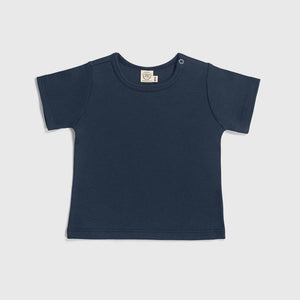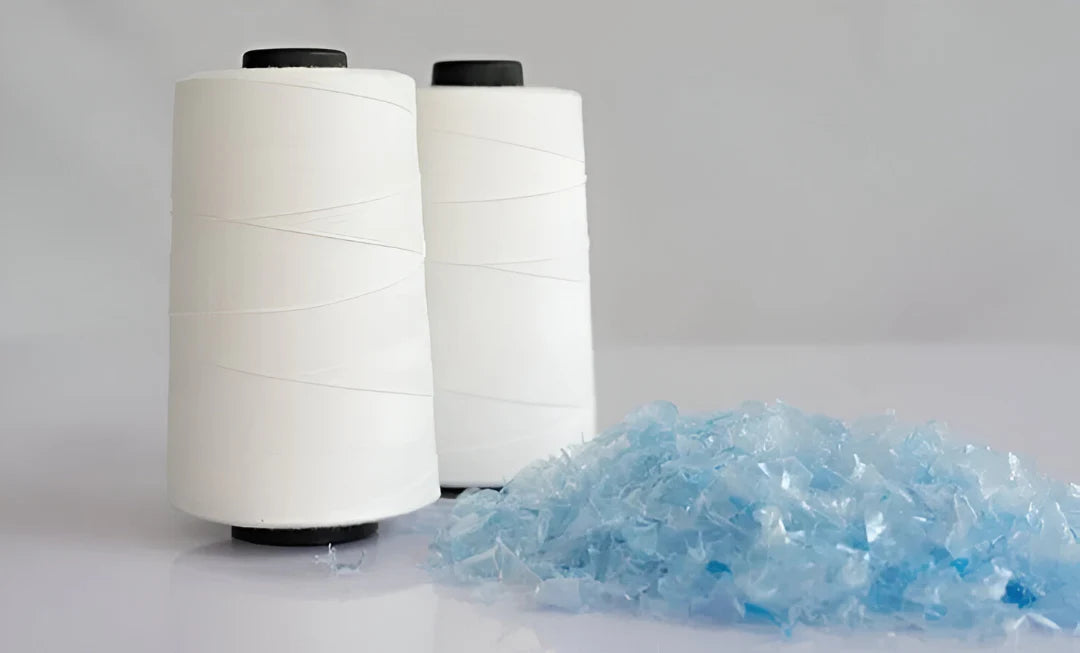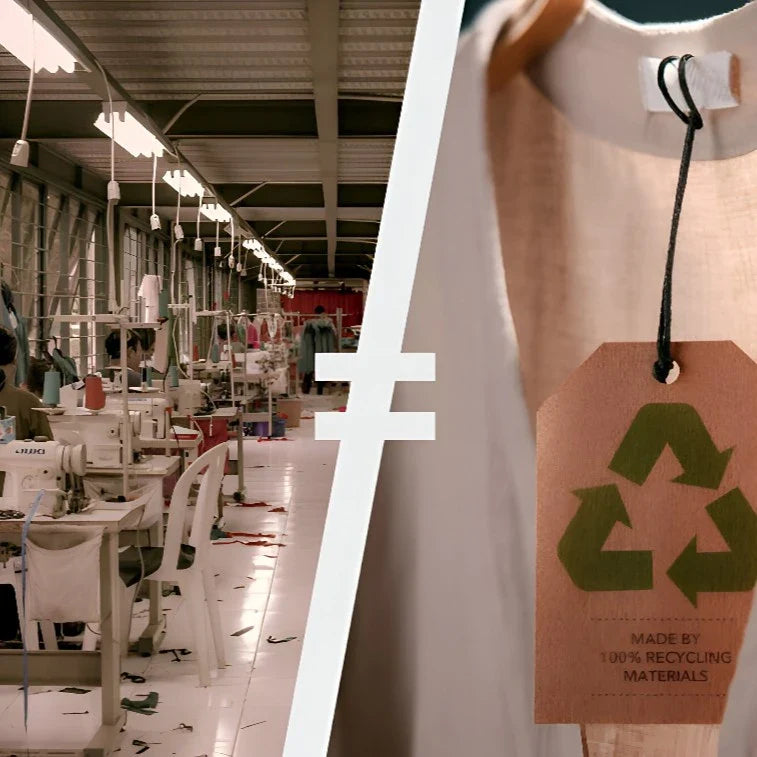Earth Day 2025:
Uniting Climate Action & Sustainable Fashion in a Divided World
.
AYA | APRIL 22, 2025
READING TIME: 5 minutes
By Jordy Munarriz & Lesia Tello
AYA | APRIL 22, 2025
READING TIME: 5 minutes
By Jordy Munarriz & Lesia Tello
Every April 22, Earth Day compels humanity to pause and evaluate our relationship with the planet, reminding us that environmental stewardship is not optional but imperative. What began as a U.S. campus‑wide teach‑in in 1970 has blossomed into an annual global mobilization, uniting over a billion people in nearly 200 countries around climate action, biodiversity protection, and sustainable living [1,2].
The First Earth Day: How a 1970 Teach-In Sparked a Global Revolution
Senator Gaylord Nelson, galvanized by a devastating 1969 oil spill in Santa Barbara and inspired by Vietnam War teach‑ins, proclaimed April 22, 1970, as a nationwide “teach‑in” for the environment [2,3]. With student leader Denis Hayes at the helm, 20 million Americans [3]—around 10% of the U.S. population—rallied across college campuses and communities, demanding clean air, water, and land. This unprecedented groundswell directly led to the creation of the U.S. Environmental Protection Agency (EPA) and landmark legislation like the Clean Air Act and Clean Water Act [3,4].

970 Teach-In Sparked a Global Revolution.
Milestones: From Teach‑Ins to Environmental Law
The inaugural Earth Day inspired a wave of environmental laws in the 1970s, setting global precedents. By 1990, Earth Day had gone global—200 million people in 141 countries participated, forging international consensus on ozone protection and deforestation. The United Nations officially recognized April 22 as “International Mother Earth Day” in 2009, cementing its place in the global environmental calendar [1,5,6].
Beyond Cleanups: Why Earth Day Must Demand Systemic Change
Despite these victories, the planet faces unprecedented crises. Global CO₂ concentrations recently topped 420 ppm [7,8], the highest in human history, accelerating extreme weather events and sea‑level rise. Plastic pollution has reached every ocean gyre, with over 8 million tons dumped annually [9]. Deforestation continues at 10 million hectares per year [10], eroding biodiversity and carbon sinks.
Although Earth Day campaigns have catalyzed some progress—Ocean Conservancy’s International Coastal Cleanup has removed over 350 million pounds of trash since 1986 [11]—these efforts merely scratch the surface of systemic change needed.

The Role of Fashion: From Fast Fashion Fallout to Sustainable Solutions
Fast fashion exemplifies modern environmental recklessness. It consumes 141 billion cubic meters of water annually and contributes 10% of global carbon emissions [12,13]—more than all international flights and shipping combined. Microplastics discharged during washing account for 35% of ocean microplastic pollution [12,13]. Moreover, less than 1% of textiles are recycled [13]—three in five garments end up incinerated or in landfills annually.
Yet a counter‑movement is rising. The global resale market is projected to reach US $900 million by 2035 as consumers shift to second‑hand buying [14,15], driven by ethical and environmental concerns. Sustainable fashion brands are growing at over 8% CAGR, investing in circular production, non‑toxic dyes, and transparent supply chains that prioritize people and planet over perpetual consumption [16].
Trump vs. China and Asian Giants: Could U.S. Tariffs Accidentally Reduce Fast Fashion Emissions by 30%?
In 2025, the U.S. lifted the de‑minimis exemption on low‑value Chinese shipments, imposing tariffs up to 155% [17,18], directly impacting ultra‑fast fashion platforms like Shein and Temu. Although intended to bolster domestic manufacturing, these tariffs have also disrupted global logistics, inflated consumer prices by an estimated 65–87% for apparel and leather goods, and spurred a surge in second‑hand retail as cost‑sensitive shoppers pivot to thrift stores [19].
Paradoxically, some analysts argue these trade barriers might curb greenhouse gas emissions by dampening the frenetic pace of fast fashion shipping and production—one study projected potential GHG reductions of 20–30% if fast fashion demand declined [20,21]. Yet critics warn that without complementary sustainability standards and support for genuine circular models, these tariffs could simply shift pollution to less regulated regions.
China responded with reciprocal levies on U.S. bourbon and agricultural products, highlighting how geopolitical jostling often overlooks collaborative solutions to shared environmental threats. As trade tensions flare, the fashion industry hangs in the balance: will it exploit loopholes, or will it embrace substantive reforms?

Representation of the opening of the Chinese market versus the closure of the United States due to Trump's tariffs.
Looking Ahead: New Horizons and Earth Day Campaigns
Earth Day 2025 marks the 55th anniversary of this global movement. Recent themes emphasize climate literacy, single‑use plastic elimination, and youth activism. In Malaysia, organizers aim to mobilize 100 000 volunteers for the largest coastal cleanup in history and plant over 1 million trees by year‑end [22]. Educational campaigns in primary and secondary schools now integrate sustainability curricula, ensuring the next generation is empowered to demand systemic change.
On the corporate front, major apparel brands have begun embedding circularity into their operations through extended producer responsibility (EPR) schemes and digital “track‑and‑trace” platforms that guide garments from cradle to grave. Legislative momentum builds worldwide: the EU’s Green Deal mandates 65% reuse and recycling of all textiles by 2030 [23], while states like California explore right‑to‑repair laws that extend garment lifespans and reduce e‑waste.
A New Era of Knowledge: Open Science and Environmental Access
One of the most profound developments of the past decade in environmental advocacy has been the democratization of scientific knowledge. Today, approximately 57% of all scholarly publications offer some level of open access, representing a critical shift in information equity [24]. This watershed moment has dramatically increased the availability of peer-reviewed research for policy-makers, educators, grassroots organizations, and young activists alike.
Environmental science, long buried behind paywalls, is finally reaching those on the frontlines of change. The open scholarship movement is not just about free PDFs—it’s about tearing down barriers that once kept science in the hands of the few and enabling a shared foundation for evidence-based action across the globe.
Changing Demographics and Preferences
The pandemic also highlighted shifting demographics in the fashion market. Younger consumers, particularly Gen Z and Millennials, became increasingly influential in shaping purchasing trends. Research from the Institute for Sustainable Fashion indicates that younger generations are more likely to support sustainable brands, with 83% of Millennials stating they prefer to buy from companies that share their values [7,8].
Moreover, with the rise of remote work, many consumers reported a preference for comfort over style. A study published in the Journal of Fashion Marketing and Management noted that comfort became the primary driver of clothing purchases for many consumers, with 65% prioritizing comfort in their buying decisions [9]. This trend is likely to persist as remote work becomes a more permanent aspect of many industries.

Changing Demographics and Preferences
The pandemic also highlighted shifting demographics in the fashion market. Younger consumers, particularly Gen Z and Millennials, became increasingly influential in shaping purchasing trends. Research from the Institute for Sustainable Fashion indicates that younger generations are more likely to support sustainable brands, with 83% of Millennials stating they prefer to buy from companies that share their values [7,8].
Moreover, with the rise of remote work, many consumers reported a preference for comfort over style. A study published in the Journal of Fashion Marketing and Management noted that comfort became the primary driver of clothing purchases for many consumers, with 65% prioritizing comfort in their buying decisions [9]. This trend is likely to persist as remote work becomes a more permanent aspect of many industries.

Changing Demographics and Preferences
The pandemic also highlighted shifting demographics in the fashion market. Younger consumers, particularly Gen Z and Millennials, became increasingly influential in shaping purchasing trends. Research from the Institute for Sustainable Fashion indicates that younger generations are more likely to support sustainable brands, with 83% of Millennials stating they prefer to buy from companies that share their values [7,8].
Moreover, with the rise of remote work, many consumers reported a preference for comfort over style. A study published in the Journal of Fashion Marketing and Management noted that comfort became the primary driver of clothing purchases for many consumers, with 65% prioritizing comfort in their buying decisions [9]. This trend is likely to persist as remote work becomes a more permanent aspect of many industries.

Changing Demographics and Preferences
The pandemic also highlighted shifting demographics in the fashion market. Younger consumers, particularly Gen Z and Millennials, became increasingly influential in shaping purchasing trends. Research from the Institute for Sustainable Fashion indicates that younger generations are more likely to support sustainable brands, with 83% of Millennials stating they prefer to buy from companies that share their values [7,8].
Moreover, with the rise of remote work, many consumers reported a preference for comfort over style. A study published in the Journal of Fashion Marketing and Management noted that comfort became the primary driver of clothing purchases for many consumers, with 65% prioritizing comfort in their buying decisions [9]. This trend is likely to persist as remote work becomes a more permanent aspect of many industries.

Oceans Beyond Borders: The High Seas Treaty
Another testament to science's impact on global policy is the adoption of the High Seas Treaty in 2023, a historic international agreement designed to protect marine biodiversity beyond national jurisdictions. Catalyzed in part by The Science of the High Seas collection, which informed the deliberations of the United Nations High Seas Commission, the treaty aims to safeguard the 60% of ocean area that lies outside any one country’s control [24].
Backed by the rigorous analysis of marine ecosystems, deep-sea species, and oceanic carbon cycles, this agreement establishes frameworks for marine protected areas, environmental impact assessments, and equitable resource-sharing. It marks a paradigm shift: for the first time in history, humanity is beginning to treat the global ocean as a commons worthy of stewardship, not exploitation.
Final Call: Time to Confront Complacency
Perhaps the most uplifting signal of Earth Day’s enduring power is the mobilization of nearly one billion people across the globe each year. From tree plantings in Kenya [25] and coral restoration in Indonesia [26] to community composters in New York [27] and beach cleanups in Portugal [28], the Earth Day movement exemplifies a universal readiness for action.
These efforts aren’t just symbolic—they reduce urban heat, absorb CO₂, regenerate ecosystems, and inspire lifelong environmental commitment. The sheer scale of participation reveals that citizens worldwide are not only aware of the planetary emergency—they are actively participating in its resolution. It’s a resounding counterpoint to despair: the world is ready.
Earth Day’s legacy teaches us that grassroots passion can reshape entire industries. Yet the scale of today’s challenges demands more than symbolic gestures. Fast fashion’s ravenous growth, geopolitical brinkmanship, and hollow “sustainability” marketing—like greenwashing and socialwashing—threaten to erode decades of progress.
At AYA, we believe that conscious choices are born from informed minds. That’s why we dedicate our voice to raising awareness about environmental challenges, celebrating local and global action, and fostering a community that values transparency, circularity, and justice. Every garment we create is a statement—against waste, against silence, and against complacency. But more than that, every campaign, every blog, and every conversation is a step toward building a culture of care that goes beyond trends.
AYA—In every thread, a promise to the planet.

Picture by: Margot Richard.
Glossarykeywords
Carbon Sinks:
Forests/oceans absorbing CO₂; deforestation erodes their capacity.
Circular Production:
Designing products for reuse/recycling to minimize waste (e.g., textile recycling)
CO₂ at 420 ppm:
Record atmospheric carbon dioxide levels, accelerating climate change.
EU Green Deal:
Mandate for 65% textile reuse/recycling by 2030 to combat waste.
Fast Fashion:
High-speed, low-cost clothing production contributing to 10% of global carbon emissions and massive waste.
High Seas Treaty (2023):
UN agreement protecting 60% of oceans outside national control, backed by open science.
Microplastics:
Tiny plastic particles from synthetic fabrics, accounting for 35% of ocean pollution.
Open Science:
Democratized access to research (57% of studies now open-access), aiding climate advocacy.
Our Power, Our Planet:
2025 theme emphasizing collective action to expand renewable energy and climate justice.
Sustainable Fashion:
Ethical production prioritizing circularity, non-toxic materials, and transparency to reduce environmental harm.
Trump Tariffs (2025):
155% U.S. tariffs on Chinese imports, impacting fast fashion and sparking trade tensions.
Authors & Researchers

Jordy Munarriz
Environmental Engineer with a master's degree in renewable energy and a specialization in sustainability. Researcher and writer, he combines his technical knowledge with his passion for environmental communication, addressing topics of ecological impact and sustainable solutions in the textile industry and beyond.

Lesia Tello
Biologist and researcher specializing in biochemistry, with a master’s degree in education. Passionate about scientific inquiry, she explores the complexities of life and the processes that sustain it. Her work focuses on the intersection of science, education, and communication, making scientific knowledge accessible and impactful.
Authors & Researchers
Authors & Researchers


Jordy Munarriz
Environmental Engineer with a master's degree in renewable energy and a specialization in sustainability. Researcher and writer, he combines his technical knowledge with his passion for environmental communication, addressing topics of ecological impact and sustainable solutions in the textile industry and beyond.
Lesia Tello
Biologist and researcher specializing in biochemistry, with a master’s degree in education. Passionate about scientific inquiry, she explores the complexities of life and the processes that sustain it. Her work focuses on the intersection of science, education, and communication, making scientific knowledge accessible and impactful.
References:
[1] Earth Day. Encyclopædia Britannica [Internet]. 2024 [cited 2025 Apr 22]. Available from: https://www.britannica.com/topic/Earth-Day
[2] Earth Day Network. Our Successes [Internet]. Washington, D.C.: Earth Day Network; [cited 2025 Apr 22]. Available from: https://www.earthday.org/our-successes/
[3] Earth Day Network. The History of Earth Day [Internet]. Washington (DC): Earth Day Network; [cited 2025 Apr 22]. Available from: https://www.earthday.org/history/
[4] U.S. Environmental Protection Agency. History of the Clean Water Act [Internet]. Washington (DC): U.S. Environmental Protection Agency; 2024 Jun 12 [cited 2025 Apr 22]. Available from: https://www.epa.gov/laws-regulations/history-clean-water-act
[5] United Nations Environment Programme. International Mother Earth Day 2025 [Internet]. 2025 Apr 22 [cited 2025 Apr 22]. Available from: https://www.unep.org/events/un-day/international-mother-earth-day-2025
[6] Bárcena A, Prado A, Samaniego J, Pérez R. Sustainable development 20 years on from the Earth Summit: progress, gaps and strategic guidelines for Latin America and the Caribbean [Internet]. Santiago (Chile): United Nations Economic Commission for Latin America and the Caribbean; 2012 Mar [cited 2025 Apr 22]. Report No.: LC/L.3346/Rev.1.
[7] World Meteorological Organization. Greenhouse gas concentrations surge again to new record in 2023 [Internet]. Geneva: World Meteorological Organization; 2024 Oct 28 [cited 2025 Apr 22]. Available from: https://wmo.int/news/media-centre/greenhouse-gas-concentrations-surge-again-new-record-2023
[8] Lindsey R. Climate Change: Atmospheric Carbon Dioxide [Internet]. NOAA Climate.gov; 2024 Apr 9 [cited 2025 Apr 22]. Available from: https://www.climate.gov/news-features/understanding-climate/climate-change-atmospheric-carbon-dioxide
[9] Fava M. Ocean plastic pollution an overview: data and statistics [Internet]. Ocean Literacy Portal. Intergovernmental Oceanographic Commission of UNESCO; 2022 May 9 [cited 2025 Apr 22]. Available from: https://oceanliteracy.unesco.org/plastic-pollution-ocean/
[10] Climate Impact Partners. The Effects of Deforestation [Internet]. 2024 Nov 28 [cited 2025 Apr 22].
[11] Ocean Conservancy. International Coastal Cleanup Annual Report 2024 [Internet]. Washington (DC): Ocean Conservancy; 2024 Sep [cited 2025 Apr 22].
[12] Bailey K, Basu A, Sharma S. The environmental impacts of fast fashion on water quality: a systematic review. Water. 2022;14(7):1073. doi:10.3390/w14071073.
[13] Niinimäki K, Peters G, Dahlbo H, et al. The environmental price of fast fashion. Nat Rev Earth Environ. 2020;1:189–200. doi:10.1038/s43017-020-0039-9.
[14] Wicker A. The trendy second-hand clothing market is huge and still growing – yet nobody is turning a profit. BBC Worklife. Published March 1, 2024. Accessed April 22, 2025.
[15] Begum H. The best fashion statement you can make this season? Buy pre‑loved [Internet]. The Guardian; 2024 Oct 1 [cited 2025 Apr 22].
[16] Geneva Environment Network. Sustainable fashion [Internet]. n.d. [cited 2025 Apr 22].
[17] China Briefing. Trump tariffs and China’s ultra-fast fashion [Internet]. n.d. [cited 2025 Apr 22].
[18] The Guardian. Trump tariffs spike fast fashion prices [Internet]. 2025 Apr 13 [cited 2025 Apr 22].
[19] AP News. Tariffs boost secondhand clothing demand [Internet]. n.d. [cited 2025 Apr 22].
[20] Onyx Newsroom. Could Trump’s tariffs aid the environment? [Internet]. n.d. [cited 2025 Apr 22].
[21] McKinsey. Fashion on climate [Internet]. n.d. [cited 2025 Apr 22].
[22] Reef Check Malaysia. International Coastal Cleanup [Internet]. n.d. [cited 2025 Apr 22]. Available from: https://www.reefcheck.org.my/international-coastal-cleanup
[23] European Council. The European Green Deal [Internet]. n.d. [cited 2025 Apr 22]. Available from: https://www.consilium.europa.eu/en/policies/european-green-deal/
[24] PubMed Central. Open science in environmental research [Internet]. 2024 [cited 2025 Apr 23]. Available from: https://pmc.ncbi.nlm.nih.gov/articles/PMC11023497/
[25] Trees for Kenya. Reforestation projects [Internet]. n.d. [cited 2025 Apr 22]. Available from: https://treeskenya.org/
[26] Razak TB, Boström-Einarsson L, Alisa CAG, Vida RT, Lamont TAC. Coral reef restoration in Indonesia: A review of policies and projects. Marine Policy. 2022 Mar;137:104940. doi:10.1016/j.marpol.2021.104940.
[27] NYC Community Compost Network [Internet]. n.d. [cited 2025 Apr 22]. Available from: https://nyccommunitycompostnetwork.org/
[28] Oceano Azul Foundation. International Coastal Cleanup Day 2022 [Internet]. 2022 [cited 2025 Apr 23]. Available from: https://www.oceanoazulfoundation.org/international-coastal-cleanup-day.2022/
Glossarykeywords
Bamboo:
The term "bamboo fabric" generally refers to a variety of textiles made from the bamboo plant. Most bamboo fabric produced worldwide is bamboo viscose, which is economical to produce, although it has environmental drawbacks and poses occupational hazards.
Cellulose Nanocrystals (CNCs):
They are rod-shaped nanoparticles derived from cellulose. They are biodegradable and renewable materials used in various fields, such as construction, medicine, and crude oil separation.
Circularity in the Textile Value Chain:
It seeks to design durable, recyclable, and long-lasting textiles. The goal is to create a closed-loop system where products are reused and reincorporated into production.
Cotton:
A soft white fibrous substance that surrounds the seeds of a tropical and subtropical plant and is used as textile fiber and thread for sewing.
Fertilizers:
These are nutrient-rich substances used to improve soil characteristics for better crop development. They may contain chemical additives, although there are new developments in the use of organic substances in their production.
Jute:
It is a fiber derived from the jute plant. This plant is composed of long, soft, and lustrous plant fibers that can be spun into thick, strong threads. These fibers are often used to make burlap, a thick, inexpensive material used for bags, sacks, and other industrial purposes. However, jute is a more refined version of burlap, with a softer texture and a more polished appearance.
Hemp:
Industrial hemp is used to make clothing fibers. It is the product of cultivating one of the subspecies of the hemp plant for industrial purposes.
Linen:
It is a plant fiber that comes from the plant of the same name. It is very durable and absorbent, and dries faster than cotton. Thanks to these properties, it is comfortable to wear in warm climates and is valued for making clothing.
Organic Cotton:
It is grown with natural seeds, sustainable irrigation methods, and no pesticides or other harmful chemicals are used in its cultivation. As a result, organic cotton is presented as a healthier alternative for the skin.
Pesticides:
It is a substance used to control, eliminate, repel, or prevent pests. Industry uses chemical pesticides for economic reasons.
Subsidy:
It can be defined as any government assistance or incentive, in cash or kind, towards private sectors - producers or consumers - for which the Government does not receive equivalent compensation in return.
The International Day of Zero Waste:
It is celebrated annually on March 30. The day's goal is to promote sustainable consumption and production and raise awareness about zero-waste initiatives.
UNEP:
The United Nations Environment Programme is responsible for coordinating responses to environmental problems within the United Nations system.
Water-Intensive Practices:
These are activities that consume large amounts of water. These practices can have significant environmental impacts, especially in water-scarce regions.
World Water Day:
It is an international celebration of awareness in the care and preservation of water that has been celebrated annually on March 22 since 1993.
Glossarykeywords
Carbon Sinks:
Forests/oceans absorbing CO₂; deforestation erodes their capacity.
CO₂ at 420 ppm:
Record atmospheric carbon dioxide levels, accelerating climate change.
EU Green Deal:
Mandate for 65% textile reuse/recycling by 2030 to combat waste.
High Seas Treaty (2023):
UN agreement protecting 60% of oceans outside national control, backed by open science.
Open Science:
Democratized access to research (57% of studies now open-access), aiding climate advocacy.
Trump Tariffs (2025):
155% U.S. tariffs on Chinese imports, impacting fast fashion and sparking trade tensions.
Glossarykeywords
Air Dye:
A waterless dyeing technology that uses air to apply color to textiles, eliminating wastewater and reducing chemical use.
Automation in Textile Production:
The use of AI, robotics, and machine learning to improve efficiency, reduce waste, and lower production costs in the fashion industry.
Carbon Emissions:
Greenhouse gases, particularly carbon dioxide (CO₂), released by industrial processes, transportation, and manufacturing, contributing to climate change.
Circular Economy:
A production and consumption model that minimizes waste and maximizes resource efficiency by designing products for durability, reuse, repair, and recycling.
CO₂ Dyeing (DyeCoo):
A sustainable dyeing technology that uses pressurized carbon dioxide instead of water, significantly reducing water waste and pollution.
Ethical Fashion:
Clothing produced in a way that considers the welfare of workers, animals, and the environment, ensuring fair wages and responsible sourcing.
Fast Fashion:
A mass production model that delivers low-cost, trend-based clothing at high speed, often leading to waste, environmental pollution, and unethical labor practices.
GOTS (Global Organic Textile Standard):
A leading certification for organic textiles that ensures responsible farming practices, sustainable processing, and fair labor conditions.
Greenwashing:
A misleading marketing strategy used by companies to appear more environmentally friendly than they actually are, often exaggerating sustainability claims.
Nanobubble Technology:
A textile treatment method that applies chemicals and dyes using microscopic bubbles, reducing water and chemical usage.
Natural Dyes:
Dyes derived from plants, minerals, or insects that are biodegradable and free from toxic chemicals, unlike synthetic dyes.
Ozone Washing:
A low-impact textile treatment that uses ozone gas instead of chemicals and water to bleach or fade denim, reducing pollution and water consumption.
Proximity Manufacturing:
The practice of producing garments close to consumer markets, reducing transportation-related carbon emissions and promoting local economies.
Recycled Polyester (rPET):
Polyester made from post-consumer plastic waste (e.g., bottles), reducing dependence on virgin petroleum-based fibers.
Slow Fashion:
A movement opposing fast fashion, focusing on sustainable, high-quality, and ethically made clothing that lasts longer.
Sustainable Fashion:
Clothing designed and manufactured with minimal environmental and social impact, using eco-friendly materials and ethical labor practices.
Upcycling:
The creative reuse of materials or textiles to create new products of equal or higher value, reducing waste without breaking down fibers.
Wastewater Recycling:
The treatment and reuse of water in textile production, minimizing freshwater consumption and reducing pollution.
Zero-Waste Design:
A fashion design approach that maximizes fabric efficiency, ensuring that no textile scraps go to waste during the cutting and sewing process.
References:
[1] Earth Day. Encyclopædia Britannica [Internet]. 2024 [cited 2025 Apr 22]. Available from: https://www.britannica.com/topic/Earth-Day
[2] Earth Day Network. Our Successes [Internet]. Washington, D.C.: Earth Day Network; [cited 2025 Apr 22]. Available from: https://www.earthday.org/our-successes/
[3] Earth Day Network. The History of Earth Day [Internet]. Washington (DC): Earth Day Network; [cited 2025 Apr 22]. Available from: https://www.earthday.org/history/
[4] U.S. Environmental Protection Agency. History of the Clean Water Act [Internet]. Washington (DC): U.S. Environmental Protection Agency; 2024 Jun 12 [cited 2025 Apr 22]. Available from: https://www.epa.gov/laws-regulations/history-clean-water-act
[5] United Nations Environment Programme. International Mother Earth Day 2025 [Internet]. 2025 Apr 22 [cited 2025 Apr 22]. Available from: https://www.unep.org/events/un-day/international-mother-earth-day-2025
[6] Bárcena A, Prado A, Samaniego J, Pérez R. Sustainable development 20 years on from the Earth Summit: progress, gaps and strategic guidelines for Latin America and the Caribbean [Internet]. Santiago (Chile): United Nations Economic Commission for Latin America and the Caribbean; 2012 Mar [cited 2025 Apr 22]. Report No.: LC/L.3346/Rev.1.
[7] World Meteorological Organization. Greenhouse gas concentrations surge again to new record in 2023 [Internet]. Geneva: World Meteorological Organization; 2024 Oct 28 [cited 2025 Apr 22]. Available from: https://wmo.int/news/media-centre/greenhouse-gas-concentrations-surge-again-new-record-2023
[8] Lindsey R. Climate Change: Atmospheric Carbon Dioxide [Internet]. NOAA Climate.gov; 2024 Apr 9 [cited 2025 Apr 22]. Available from: https://www.climate.gov/news-features/understanding-climate/climate-change-atmospheric-carbon-dioxide
[9] Fava M. Ocean plastic pollution an overview: data and statistics [Internet]. Ocean Literacy Portal. Intergovernmental Oceanographic Commission of UNESCO; 2022 May 9 [cited 2025 Apr 22]. Available from: https://oceanliteracy.unesco.org/plastic-pollution-ocean/
[10] Climate Impact Partners. The Effects of Deforestation [Internet]. 2024 Nov 28 [cited 2025 Apr 22].
[11] Ocean Conservancy. International Coastal Cleanup Annual Report 2024 [Internet]. Washington (DC): Ocean Conservancy; 2024 Sep [cited 2025 Apr 22].
[12] Bailey K, Basu A, Sharma S. The environmental impacts of fast fashion on water quality: a systematic review. Water. 2022;14(7):1073. doi:10.3390/w14071073.
[13] Niinimäki K, Peters G, Dahlbo H, et al. The environmental price of fast fashion. Nat Rev Earth Environ. 2020;1:189–200. doi:10.1038/s43017-020-0039-9.
[14] Wicker A. The trendy second-hand clothing market is huge and still growing – yet nobody is turning a profit. BBC Worklife. Published March 1, 2024. Accessed April 22, 2025.
[15] Begum H. The best fashion statement you can make this season? Buy pre‑loved [Internet]. The Guardian; 2024 Oct 1 [cited 2025 Apr 22].
[16] Geneva Environment Network. Sustainable fashion [Internet]. n.d. [cited 2025 Apr 22].
[17] China Briefing. Trump tariffs and China’s ultra-fast fashion [Internet]. n.d. [cited 2025 Apr 22].
[18] The Guardian. Trump tariffs spike fast fashion prices [Internet]. 2025 Apr 13 [cited 2025 Apr 22].
[19] AP News. Tariffs boost secondhand clothing demand [Internet]. n.d. [cited 2025 Apr 22].
[20] Onyx Newsroom. Could Trump’s tariffs aid the environment? [Internet]. n.d. [cited 2025 Apr 22].
[21] McKinsey. Fashion on climate [Internet]. n.d. [cited 2025 Apr 22].
[22] Reef Check Malaysia. International Coastal Cleanup [Internet]. n.d. [cited 2025 Apr 22]. Available from: https://www.reefcheck.org.my/international-coastal-cleanup
[23] European Council. The European Green Deal [Internet]. n.d. [cited 2025 Apr 22]. Available from: https://www.consilium.europa.eu/en/policies/european-green-deal/
[24] PubMed Central. Open science in environmental research [Internet]. 2024 [cited 2025 Apr 23]. Available from: https://pmc.ncbi.nlm.nih.gov/articles/PMC11023497/
[25] Trees for Kenya. Reforestation projects [Internet]. n.d. [cited 2025 Apr 22]. Available from: https://treeskenya.org/
[26] Razak TB, Boström-Einarsson L, Alisa CAG, Vida RT, Lamont TAC. Coral reef restoration in Indonesia: A review of policies and projects. Marine Policy. 2022 Mar;137:104940. doi:10.1016/j.marpol.2021.104940.
[27] NYC Community Compost Network [Internet]. n.d. [cited 2025 Apr 22]. Available from: https://nyccommunitycompostnetwork.org/
[28] Oceano Azul Foundation. International Coastal Cleanup Day 2022 [Internet]. 2022 [cited 2025 Apr 23]. Available from: https://www.oceanoazulfoundation.org/international-coastal-cleanup-day.2022/
You don't have to put all the weight on your shoulders. Every action counts. At AYA, we fight microplastic pollution by making a 100% plastic-free catalog.
Visit Our Shop →You May Also Like to Read...
The Truth About Recycled Polyester in Fashion
Discover the hidden costs of recycled polyester. Learn why rPET isn't as sustainable as it seems and what real circular alternatives look like.
Synthetic Fabrics vs. Organic Cotton: Impact on Skin Health
Discover how polyester and other synthetic fabrics can irritate your skin and why organic cotton, especially Pima cotton, is a healthier and safer choice for sensitive skin.
What Peru Whispers: Organic Pima Cotton Grown with Tradition and Care
In the quiet corners of Peru, organic pima cotton is grown with respect for the land. A luxurious, timeless textile waiting to be discovered.
Why Sustainable Fashion Shouldn’t Be Fast Fashion
Recycled materials and green labels won’t fix fast fashion. Discover why real sustainability means slowing down.
















